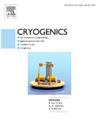CFD validation of k-site tank self-pressurization under varying fill levels and heat fluxes with different turbulence models
IF 2.1
3区 工程技术
Q3 PHYSICS, APPLIED
引用次数: 0
Abstract
Accurate prediction of cryogenic tank self-pressurization is critical for NASA’s short- and long-duration missions, where heat leakage into storage systems occurs through insulation, structural supports, and penetrations. To address this need, a two-phase CFD model was developed to simulate the self-pressurization of a cryogenic storage tank partially filled with liquid hydrogen. The model employed the Volume-Of-Fluid (VOF) approach to capture two-phase flow behavior, incorporating interfacial heat, mass and momentum transfer between the liquid and vapor phases. Validation was carried out against self-pressurization experiments performed using the K-site flightweight hydrogen storage tank at NASA Glenn Research Center. Initial validation focused on a 49 % liquid fill level followed by extension to additional fill levels of 29 % and 83 %, studied in the experiment. Laminar and turbulent simulations were performed, along with conjugate heat transfer, to evaluate pressurization dynamics across different operating conditions. Numerical results for tank pressures and fluid temperature are compared with experimental data under external tank heat fluxes of 3.5 and 2.0 W/m2. The effects of turbulence modeling, liquid fill level, and localized heat leaks through instrumentation penetrations are analyzed and discussed in detail.
不同湍流模型下不同液位和热通量下k-site罐自压的CFD验证
低温储罐自增压的准确预测对于NASA的短期和长期任务至关重要,在这些任务中,热泄漏会通过绝缘、结构支撑和穿透进入存储系统。为了满足这一需求,开发了一个两相CFD模型来模拟部分充满液态氢的低温储罐的自加压。该模型采用了流体体积(VOF)方法来捕捉两相流动行为,结合了液相和气相之间的界面热量、质量和动量传递。在美国宇航局格伦研究中心的k站点飞行重量储氢罐上进行了自加压实验,验证了该方法的有效性。最初的验证集中在49%的液体填充水平,随后扩展到29%和83%的额外填充水平,在实验中研究。层流和湍流模拟以及共轭传热进行了模拟,以评估不同操作条件下的增压动力学。在罐外热通量为3.5和2.0 W/m2时,对罐内压力和流体温度的数值计算结果与实验数据进行了比较。详细分析和讨论了湍流模拟、液体填充水平和仪器穿透局部热泄漏的影响。
本文章由计算机程序翻译,如有差异,请以英文原文为准。
求助全文
约1分钟内获得全文
求助全文
来源期刊

Cryogenics
物理-热力学
CiteScore
3.80
自引率
9.50%
发文量
0
审稿时长
2.1 months
期刊介绍:
Cryogenics is the world''s leading journal focusing on all aspects of cryoengineering and cryogenics. Papers published in Cryogenics cover a wide variety of subjects in low temperature engineering and research. Among the areas covered are:
- Applications of superconductivity: magnets, electronics, devices
- Superconductors and their properties
- Properties of materials: metals, alloys, composites, polymers, insulations
- New applications of cryogenic technology to processes, devices, machinery
- Refrigeration and liquefaction technology
- Thermodynamics
- Fluid properties and fluid mechanics
- Heat transfer
- Thermometry and measurement science
- Cryogenics in medicine
- Cryoelectronics
 求助内容:
求助内容: 应助结果提醒方式:
应助结果提醒方式:


